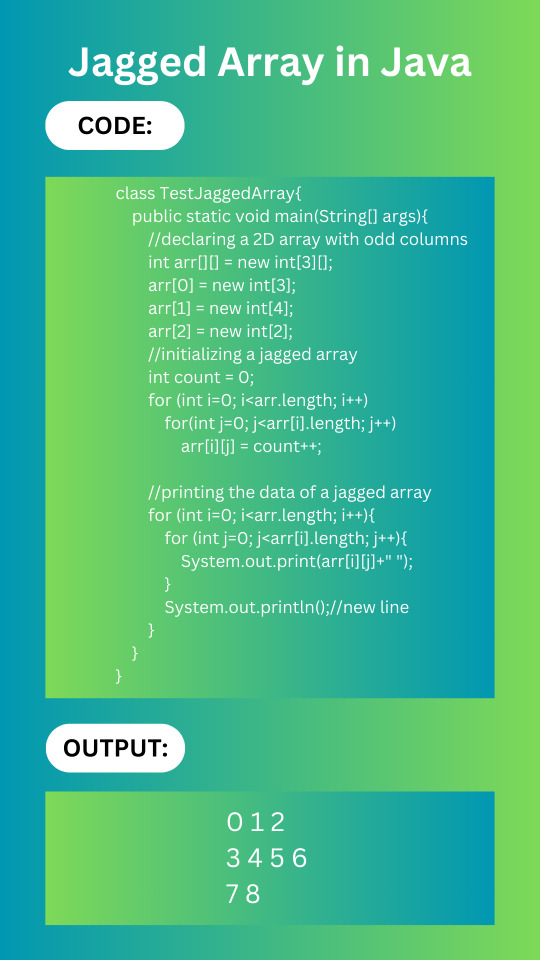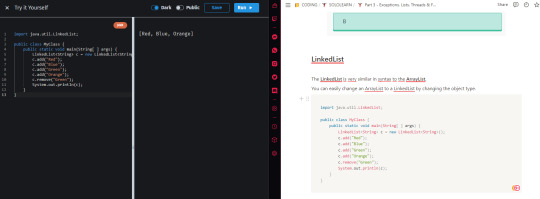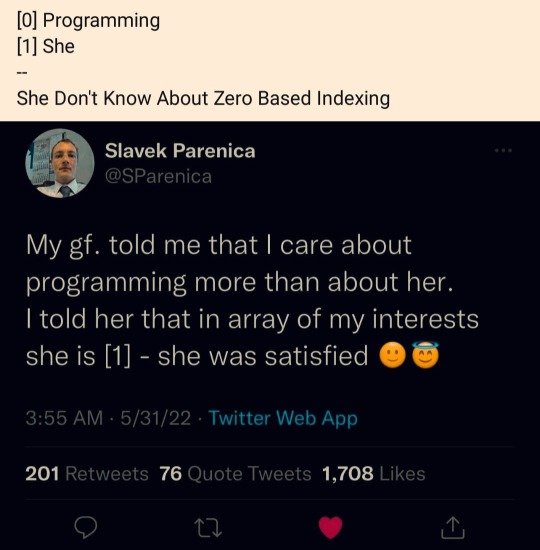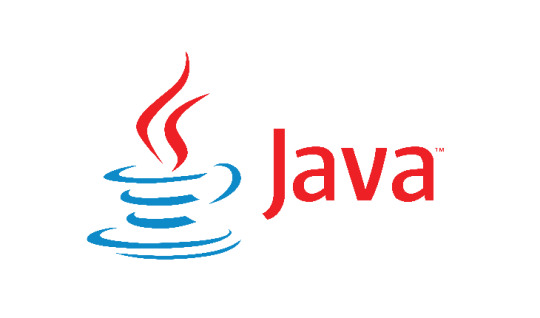#java array
Text
Array Vs Lists in Java (With Examples)
Define List In Java
In Java, A List is an ordered collection of an object in which values can be stored. It allows insertion, delete, update and positional access elements in list with index number. List created by the following classes(ArrayList, LinkedList , Stack, Vector).
The list method is found in java.util.List package. using this package we can iterate list in forward and backward directions. The implementation of classes of list are ArrayList, LinkedList, Stack, vector. The arrayList and linkedList are widly uesd in java. The vector class is deprecated scince java5
How to create a List in JAVA
Implementation of Array List:-
Syntax: List<String> lst1=New ArrayList<>();
Implementation of Linked List:-
Syntax: List<String> lst2=new LinkedList<>();
Different types of Methods of List in Java.
Some of List methods are commonly used in java are:
add() - It is used to add new Element in a list.
addAll()- It is used for add all elements of a list to a new list.
get() - It is used to access any element in a list.
set() - It is used for change element in a List. (More)
#arraylist in java#arrays in java#array in java#arraylist in java with examples#array#array list#java arrays#array list in java#dynamic array#arrays#disadvantages of arrays in java#arraylist in java example#arrays and collections in java#linked list vs array list java#arraylists in java#array tutorial in java#shifting in array list#java array#collection framework in java#linkedlist in java#difference between array and arraylist in java
0 notes
Text
yeah sex is nice but have you ever found exactly what you were looking for on the first google search??
#bliss#absolute bliss#uncontrollable moaning#unbridled passion#relatable posts#relatable#very relatable#coding#codeblr#java#programming#computer science#computer#technology#looked up frequency in array java and found 'Program to find frequency of an array'#*orgasms cause I don't have to do any work*#they even made a marquee#*cries*
182 notes
·
View notes
Text

Jagged Array in Java
Let's see the code for Jagged array in Java:
#java#javalanguage#javaprogramming#programming#coding#code#trending#education#technology#tech#engineering#software#development#softwaredevelopment#computer#computertechnology#method#array#online
2 notes
·
View notes
Photo

30 January - 100 days of Productivity - 29/100
Incredible how life always finds a way to make you crazy with so many things happening around you! Sorry for not posting these past few days, family health issues in the family.
Strange, how to maintain a study routine is helping me to do not freaking out.
Keep studying, you all!
Have a nice week guys <3
#100 days of productivity#100 days of code#100 days of coding#sololearn#study#studyblr#studying#java#arrays#coding#coding community#programming community#programming#stemblr#back to basics#study blog#motivation#productivity#keep dreaming#keep studying#keepsupporting#notion
27 notes
·
View notes
Text
Normally I just post about movies but I'm a software engineer by trade so I've got opinions on programming too.
Apparently it's a month of code or something because my dash is filled with people trying to learn Python. And that's great, because Python is a good language with a lot of support and job opportunities. I've just got some scattered thoughts that I thought I'd write down.
Python abstracts a number of useful concepts. It makes it easier to use, but it also means that if you don't understand the concepts then things might go wrong in ways you didn't expect. Memory management and pointer logic is so damn annoying, but you need to understand them. I learned these concepts by learning C++, hopefully there's an easier way these days.
Data structures and algorithms are the bread and butter of any real work (and they're pretty much all that come up in interviews) and they're language agnostic. If you don't know how to traverse a linked list, how to use recursion, what a hash map is for, etc. then you don't really know how to program. You'll pretty much never need to implement any of them from scratch, but you should know when to use them; think of them like building blocks in a Lego set.
Learning a new language is a hell of a lot easier after your first one. Going from Python to Java is mostly just syntax differences. Even "harder" languages like C++ mostly just mean more boilerplate while doing the same things. Learning a new spoken language in is hard, but learning a new programming language is generally closer to learning some new slang or a new accent. Lists in Python are called Vectors in C++, just like how french fries are called chips in London. If you know all the underlying concepts that are common to most programming languages then it's not a huge jump to a new one, at least if you're only doing all the most common stuff. (You will get tripped up by some of the minor differences though. Popping an item off of a stack in Python returns the element, but in Java it returns nothing. You have to read it with Top first. Definitely had a program fail due to that issue).
The above is not true for new paradigms. Python, C++ and Java are all iterative languages. You move to something functional like Haskell and you need a completely different way of thinking. Javascript (not in any way related to Java) has callbacks and I still don't quite have a good handle on them. Hardware languages like VHDL are all synchronous; every line of code in a program runs at the same time! That's a new way of thinking.
Python is stereotyped as a scripting language good only for glue programming or prototypes. It's excellent at those, but I've worked at a number of (successful) startups that all were Python on the backend. Python is robust enough and fast enough to be used for basically anything at this point, except maybe for embedded programming. If you do need the fastest speed possible then you can still drop in some raw C++ for the places you need it (one place I worked at had one very important piece of code in C++ because even milliseconds mattered there, but everything else was Python). The speed differences between Python and C++ are so much smaller these days that you only need them at the scale of the really big companies. It makes sense for Google to use C++ (and they use their own version of it to boot), but any company with less than 100 engineers is probably better off with Python in almost all cases. Honestly thought the best programming language is the one you like, and the one that you're good at.
Design patterns mostly don't matter. They really were only created to make up for language failures of C++; in the original design patterns book 17 of the 23 patterns were just core features of other contemporary languages like LISP. C++ was just really popular while also being kinda bad, so they were necessary. I don't think I've ever once thought about consciously using a design pattern since even before I graduated. Object oriented design is mostly in the same place. You'll use classes because it's a useful way to structure things but multiple inheritance and polymorphism and all the other terms you've learned really don't come into play too often and when they do you use the simplest possible form of them. Code should be simple and easy to understand so make it as simple as possible. As far as inheritance the most I'm willing to do is to have a class with abstract functions (i.e. classes where some functions are empty but are expected to be filled out by the child class) but even then there are usually good alternatives to this.
Related to the above: simple is best. Simple is elegant. If you solve a problem with 4000 lines of code using a bunch of esoteric data structures and language quirks, but someone else did it in 10 then I'll pick the 10. On the other hand a one liner function that requires a lot of unpacking, like a Python function with a bunch of nested lambdas, might be easier to read if you split it up a bit more. Time to read and understand the code is the most important metric, more important than runtime or memory use. You can optimize for the other two later if you have to, but simple has to prevail for the first pass otherwise it's going to be hard for other people to understand. In fact, it'll be hard for you to understand too when you come back to it 3 months later without any context.
Note that I've cut a few things for simplicity. For example: VHDL doesn't quite require every line to run at the same time, but it's still a major paradigm of the language that isn't present in most other languages.
Ok that was a lot to read. I guess I have more to say about programming than I thought. But the core ideas are: Python is pretty good, other languages don't need to be scary, learn your data structures and algorithms and above all keep your code simple and clean.
#programming#python#software engineering#java#java programming#c++#javascript#haskell#VHDL#hardware programming#embedded programming#month of code#design patterns#common lisp#google#data structures#algorithms#hash table#recursion#array#lists#vectors#vector#list#arrays#object oriented programming#functional programming#iterative programming#callbacks
6 notes
·
View notes
Text
GAY SEX RESUME (for getting hired)
Byte Ofsoup looking for a job in sex with ladies
Age years old
graduated from school
Gender[] myGender = {F, M, X};
Skills:
• Can give mid head
• Can play songs from hit neutral milk hotel album "in the aeroplane over the sea" on guitar kinda ok
• Can make minesweeper in java
Experience:
• 11th grade html bootcamp
• had a boyfriend once
6 notes
·
View notes
Text
DAY 3 of surviving java
Today, in my journey of learning Java, I delved into the concepts of arrays and time/space complexity. It was an exciting day filled with many new insights and discoveries. In this post, I'll share with you some of the things I learned.
Arrays are a fundamental concept in programming, and Java provides a robust set of tools for working with them. An array is a collection of data elements that are of the same data type. The elements of an array are stored in contiguous memory locations, making them easy to access and manipulate.
To declare an array in Java, we use the following syntax:
cssCopy code
dataType[ ] arrayName = new dataType[arraySize];
For example, to create an array of integers with ten elements, we would write:
goCopy code
int[ ] numbers = new int[10];
We can then access the elements of the array using the index notation, like this:
cssCopy code
numbers[0] = 1; numbers[1] = 2;
We can also use loops to iterate over the elements of an array and perform operations on them.
In addition to learning about arrays, I also studied time and space complexity, which are important concepts for analyzing the efficiency of algorithms. Time complexity refers to the amount of time an algorithm takes to execute, while space complexity refers to the amount of memory an algorithm uses.
We can measure time and space complexity using the Big O notation, which expresses the upper bound of an algorithm's time and space requirements. For example, an algorithm with a time complexity of O(n) means that its execution time grows linearly with the size of the input data.
Understanding time and space complexity is crucial for writing efficient and scalable code, which is particularly important in large-scale software systems.
Overall, Day 3 of learning Java was a productive and educational experience. I'm excited to continue exploring the language and discovering new concepts and tools. Stay tuned for more updates on my journey!
4 notes
·
View notes
Text

#it#it services#Python#java#programming#programmer#linux#code#service#product#design#array#indexing#tranding#software developer#engineer#computer science#computer
3 notes
·
View notes
Text

1 note
·
View note
Text
Those wise, old Javanese
Yesterday I discovered "Arrays of Wisdom of the Ancients", Aleksey Shipilёv's 2016 quest for the most efficient way to convert Java collections into arrays. It's a fascinating story. Aleksey explains why the conversion API is the way it is, then presents some counter-intuitive measurements.
Next he makes an important point about performance analysis:
At this point, most people make the major mistake: they run with these numbers as if they are the truth. But these numbers are just data, they don’t mean anything unless we extract the insights out of them. To do that, we need to see why the numbers are like that.
To gain such insight, Aleksey uses various profiling tools. After pursuing some related questions (which lure him back into the spiderweb-encrusted days of Java 1.6), he concludes by making another point I adore:
most of the time, the straight-forward code is fast enough, so stop philosophizing about angels on the head of a pin, and get back to work. 99.9% of applications do not need a dedicated team of performance engineers; they need instead for their developers to focus on writing clear, maintainable code, and a little bit of measurement and tuning to file off the rough edges when the code fails to meet the performance requirements.
Here's the URL, in case you want to read the original post:
#java#software engineering#coding#jvm#arrays#collections#wisdom#software development#performance#measurements#profile app#old news#tuning#computer history#efficiency#war stories#good enough
1 note
·
View note
Text
Pengertian ArrayList Bahasa Java beserta Contohnya
Dalam artikel duniailkom kali ini kita akan membahas apa itu ArrayList dan bagaimana contoh kode programnya. Selain itu akan dijelaskan juga perbedaan Array biasa dengan ArrayList di bahasa pemrograman Java.
Pengertian ArrayList
ArrayList adalah struktur data yang digunakan untuk menyimpan kumpulan data dalam bahasa Java. Berbeda dengan tipe data array biasa, ArrayList memiliki ukuran yang…

View On WordPress
1 note
·
View note
Text

Types of Array in java
There are two types of array in Java which are as follows:
#java#javalanguage#javaprogramming#programming#coding#code#trending#education#c#tech#engineering#software#development#softwaredevelopment#typesofarray#array#typesofarrays#online
1 note
·
View note
Text
#learn#learn to code#learning#software#applications#development#web#html#css#javascript#arrays#lists#structured#data#design#java#programming#free#paid certificate
1 note
·
View note
Text
Elemental! Arrays in Java
Java will allow us to store a specific number of like items in an array and reference each independently. #java #syntax #arrays #collections
💚 TIP: References Quick List
Java: Arrays
Java: Arrays Javadoc
What can we do if we have a set number of related items that we want to store together? In Java, an array might be the answer.
Array Indices
In Java we can store a collection of similar data as elements in an array. Arrays are created with a specified length – they have a fixed number of elements that can be stored. Elements in…
View On WordPress
0 notes
Text
Read and Print Array elements in java
public class TestArray{public static void main(String[] args) { double[] myList = {1.8, 2.9, 3.4, 3.5};// Print all the array elementsfor (int i = 0; i < myList.length; i++) {System.out.println(myList[i] + ” “);}// Summing all elements double total = 0;double total = 0;for (int i = 0; i < myList.length; i++) { total += myList[i];}System.out.println(“Total is ” + total); // Finding the largest…
View On WordPress
0 notes
Text
beautiful programming names to name your child
Ruby
Java
Rust
Elif
Array
Boolean
Pointer
Byte
Linked list
Foo Bar
child
parent
string
return
OOP
Julia
3K notes
·
View notes